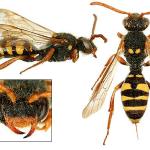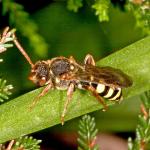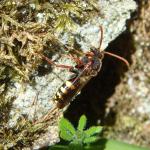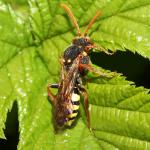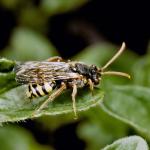Apis marshamella Kirby, 1802, Nomada marshamella var. dubia Schmiedeknecht, 1882, Nomada marshamella var. modesta_homonym Schmiedeknecht, 1882
This cuckoo bee is easily confused in the field with its close relative Nomada fulvicornis Fabricius (see remarks under that species).
Distributed throughout much of Britain, from southern England to northern Scotland. Similarly widespread in Ireland. It is known too from the Inner Hebrides (Rum) and the Isle of Man. Surprisingly, there are no records of the bee from the Channel Islands, despite the abundance on several of the islands of its main host bee, Andrena carantonica Pérez (= scotica Perkins).
Widely distributed in Europe, from southern Finland (Söderman & Leinonen, 2003) to Corsica and Malta, and further east to Turkey.
This species is not regarded as being scarce or threatened.
A very common species, occurring in many habitats, both coastal and inland. Regularly observed in private gardens in rural and urban situations.
Apparently both univoltine and bivoltine, depending on the host Andrena which is attacked. The univoltine form is apparently associated with A. carantonica and A. nigroaenea (Kirby) and flies in the spring and early summer from early April to late June. The host of the bivoltine form is not known for certain but it may attack both broods of A. trimmerana (Kirby) and late nesting A. carantonica and nigroaenea, both the latter
species having a single, greatly extended flight period. This form flies from April to June and again from late June to the beginning of September. The Nomada is certainly more numerous in the spring and early summer than later in the year.
This species is mainly a cleptoparasite of Andrena carantonica. There are reports of the bee observed to enter nest burrows of this Andrena and also recovered from within such a burrow (Chambers, 1949; G M Spooner, pers. comm.). Other possible host bees are: Andrena ferox Smith (Yarrow & Guichard, 1941; pers. obs.), A. trimmerana (Perkins, 1919), A. nigroaenea (Chambers, 1949) and A. haemorrhoa (Fabricius) (at burrows, Gardner, 1901). In the former Czechoslovakia, Kocourek (1966) reports A. rosae Panzer as a host
species of N. marshamella.
There are numerous flower records, including the following: thrift, white willow, eared willow, creeping willow, cuckoo-flower, cabbage, rhododendron, bilberry, gooseberry, bramble, blackthorn, wild cherry, hawthorn, wood spurge, alder buckthorn, sycamore, bloody crane’s-bill, alexanders, hogweed, wild carrot, bogbean, forget-me-not, speedwell, creeping thistle, dandelion, daisy, hemp-agrimony, bluebell, and threecornered garlic.
No data available.
2012


